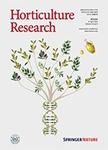What makes turnips:anatomy,physiology and transcriptome during early stages of its hypocotyl-tuber development
作者机构:Plant BreedingWageningen University and ResearchWageningenthe Netherlands Key Laboratory of Vegetable Germplasm Innovation and Utilization of HebeiCollaborative Innovation Center of Vegetable Industry in HebeiCollege of HorticultureHebei Agricultural UniversityBaodingChina Biosystematics GroupWageningen University and ResearchWageningenthe Netherlands Department of Plant ScienceUniversity of CaliforniaDavisCAUSA
出 版 物:《Horticulture Research》 (园艺研究(英文))
年 卷 期:2019年第6卷第1期
页 面:1364-1377页
核心收录:
学科分类:0710[理学-生物学] 071001[理学-植物学] 07[理学]
基 金:supported by the China Scholarship Council(CSC,No.201608130113) the work of Ningwen Zhang was financially supported by the Program Strategic Alliances of the Dutch Royal Academy of Sciences(KNAW,PSA program 08-PSA-BD-02)
主 题:organs metabolism anatomy
摘 要:Brassica species are characterized by their tremendous intraspecific diversity,exemplified by leafy vegetables,oilseeds,and crops with enlarged inflorescences or above ground storage *** contrast to potato tubers that are edible storage organs storing energy as starch and are the vegetative propagation modules,the storage organs of turnips,grown from true seed,are swollen hypocotyls with varying degrees of root and stem that mainly store glucose and *** highlight their anatomical origin,we use the term“hypocotyl-tuberfor these turnip vegetative storage *** combined cytological,physiological,genetic and transcriptomic approaches,aiming to identify the initial stages,molecular pathways and regulatory genes for hypocotyl-tuber induction in turnips(*** ***).We first studied the development of the hypocotyl zone of turnip and Pak choi and found that 16 days after sowing(DAS)morphological changes occurred in the xylem which indicated the early tuberization *** culture experiments showed a clear effect of auxin on hypocotyl-tuber *** expressed genes between 1 and 6 weeks after sowing in turnip hypocotyls,located in genomic regions involved in tuber initiation and/or tuber growth defined by QTL and selective sweeps for tuber formation,were identified as candidate genes that were studied in more detail for their role in hypocotyl-tuber *** included a Bra-FLOR1 paralogue with increased expression 16 DAS,when the hypocotyl starts swelling,suggesting dual roles for duplicated flowering time genes in flowering and hypocotyltuber ***-CYP735A2 was identified for its possible role in tuber growth via *** Coexpression Network Analysis(WGCNA)identified 59 modules of co-expressed ***-FLOR1 and Bra-CYP735A2 were grouped in a module that included several genes involved in carbohydrate transport and metabolism,cell-wall growth,auxin regulation and secondary metabolism that serve as star




